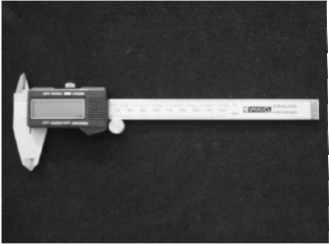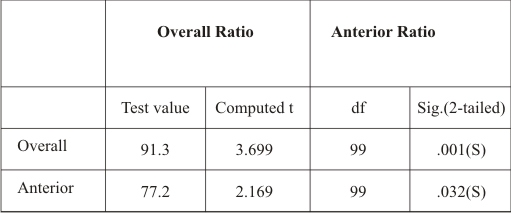INTRODUCTION
One of the basic fundamentals with which the orthodontist has to deal in reconstructing the denture is tooth size, specifically the mesiodistal width of the teeth.1
Specific dimensional relationships must exist between the maxillary and mandibular teeth to ensure proper interdigitation, overbite and overjet. Tooth size ratios represent a valid diagnostic tool that allows for prediction of treatment outcomes and may also limit the necessity for diagnostic setups for complex cases. A proper relationship of the total mesiodistal width of the maxillary dentition to the mandibular dentition will favour an optimal post treatment occlusion.2
Pioneer investigation on tooth sizes were conducted by Black in 19023, and Neff in 19494, 5. These studies were followed by classic work of Dr Wayne Bolton in 19581, 6 who selected 55 cases of Caucasian population with optimal occlusion and compared the sums of mesiodistal widths of the maxillary and mandibular teeth, including first molars. An overall ratio of 91.3 and anterior ratio of 77.2 was obtained.
Although, Bolton’s analysis has proven extremely useful in the clinical setting to guide the orthodontist in cases with extreme tooth size discrepancies , it is not without limitations. First Bolton’s estimates of evaluation were underestimated because his sample was derived from perfect Class I occlusion7, 8. Second and perhaps more important, the population and gender composition of Bolton’s sample were not specified, which implies potential selection bias.
There is good evidence that populations differ with respect to interarch tooth size relationships because differences in tooth sizes are not systematic9. Because the population and gender differences in maxillary tooth size are not same as the differences in mandibular tooth size, different interarch relationships might be expected.
The aim of the study was to determine whether the mean overall and anterior ratio of Himachali Ethnic Population would significantly differ from Caucasian (Bolton) values.
MATERIALS AND METHODS
The sample consisted of good quality study casts of both maxillary and mandibular of 50 males and 50 females with the age range of 18-22 years of Himachali ethnic population. To minimize error variance, the following selected criteria were used.
1. Fully erupted permanent dentition from first molar to first molar.
2. Himachali ethinicity.
3. Good quality study models.
4. Class I molar and canine relationship.
5. An overjet and overbite of 2-3 mm.
Exclusion criteria included:
1. Gross restorations, buildups, crowns, onlays, class II amalgams or composite restorations that affect the tooth mesiodistal diameter.
2. Congenital defects
3. Deformed teeth
4. Obvious inter proximal or occlusal wear of teeth
5. Any prior orthodontic treatment
On the dental cast of each subject, each tooth from the maxillary and mandibular right first molar to the left first molar was measured at the largest mesiodistal dimension to the nearest 0.01 mm, using a digital Vernier caliper (Fig.1). The mesiodistal dimensions were obtained by measuring the maximum distance between the two sides of the tooth on a line parallel to occlusal and buccal surfaces with the Vernier caliper held perpendicular to the long axis of each tooth (Fig 2).
 | Fig 1
 |
The Bolton anterior ratio i.e. the ratio between the mesiodistal widths of the 6 anterior mandibular teeth and mesiodistal width of the 6 anterior maxillary teeth and the Bolton overall ratio i.e. the ratio between the mesiodistal widths of the 12 mandibular teeth and the mesiodistal width of the 12 maxillary teeth from the first permanent molar to first permanent molar were calculated. A 2-sample t-test was used to test for statistical difference between means.
RESULTS
The results are summarized in Table –1.It reports the mean, standard duration, range of overall ratio and anterior ratio of male and female Himachali population.
Table 1: Mean, Standard deviation and range of the overall ratio and anterior ratio for the male and female groups of Himachali ethnic population
In Himachali ethnic population the OR was 92.42 for male and 91.62 for females. The AR was 77.89 for males and 77.45 for females
Table-2 describes the t-statistics. Statistical analysis of these results showed no significant difference between the Himachali male and female OR and AR
Table 2: t-statistics comparing overall ratio and anterior ratio of male and female Himachali subjects
Table-3 and Table-4 presents a profile of the mean, standard duration, range of the OR and AR of Himachali and Caucasians.
Table 3: Comparing overall ratio of Himachali and Caucasian subjects
Table 4: Comparing anterior ratio of Himachali and Caucasian subjects
The mean Himachali OR is 92.02% as compared to the Caucasian OR which is 91.3% while the mean AR for Himachalis was 77.67% and 77.2% for Caucasian.
Table-5 shows t-test comparing the OR and AR values of Himachalis and Caucasians. The results showed that there were significant difference between the Himachali and Caucasian population with regards to the OR and AR based on the Bolton study.
Table 5: t-statistics comparing overall ratio and anterior ratio of Himachali and Caucasian subjects
 |
 |
DISCUSSION
Dunn and Dobzhansky10 have indicated that all men belong to a single species but men inhabiting different parts of world are not alike. In the present study, the mean tooth size ratios using Himachali subject was different from Bolton’s measurements using Caucasian subject.
This study contained a large dispersion of the OR and AR for Himachali subjects. This study had a standard deviation for OR - 1.94 and AR - 2.17. As compared with Bolton’s SD in OR was 1.91 and in AR - 1.65. The difference in these studies could be accounted to the samples involved as Bolton study used a sample of 55 subjects and this present study had a sample size of 100 subjects, or this could imply small degree of variation among Caucasian tooth sizes.
The overall ratio and anterior ratio using Himachali subjects was different from Bolton’s measurements. This can be possibly explained by variations in mesiodistal dimensions of specific teeth, the maxillary teeth showing greater variability than the mandibular teeth. The mesiodistal dimension of maxillary lateral incisor, second premolar, first molar was less and that of mandibular second premolar was more in Himachali subjects as compared to Caucasian subjects of a study by Judica Balders- Dizon11 on Bolton tooth size analysis of Filipinos. The clinical importance of this finding is the non-applicability of Bolton’s values for Himachali population. Similar results were seen in a study done by Singh SP and Goyal A12 on Punjabi population who showed AR - 78% and OR - 96.53% which are more than Bolton’s values.
In another study done by Uysal T and Sari Z13 on Turkish population the OR - 89.88% and AR - 78.26% which were significantly different form that of Bolton’s population.
In a study done on Nepalese population, Qu Hong et al14 found out that the AR - 78.04% is different and OR - 91.22% is similar to that of Bolton’s values.
Our results agree with the results of a study done by Smith SS et al15 on 3 populations of Whites, Blacks and Hispanics which showed that OR and AR the three populations (except AR of White females) differed significantly from Bolton’s values. On the basis of the foregoing, it is clear that the Bolton’s ratios are not applicable across all populations. Separate standards for different populations are needed.
CONCLUSIONS
• In general, the values obtained from this study for Himachalis closely resembled the data of Caucasian population but not fully as there were variations in the mesiodistal dimensions of few teeth . Mesiodistal dimensions of maxillary lateral incisor, second premolar, and first molar were smaller and that of mandibular second premolar were larger in Himachali subjects.
• It can be suggested that Bolton values can not be used in Himachali population.
• Hence, population specific standards are necessary to be formed for clinical assessment.
REFERENCES
1. Bolton WA. Disharmonies in tooth size and its relation to the analysis and treatment of malocclusions. Angle Orthod 1958; 28:113-30.
2. Santoro M, Michael E. Ayoub, Victor Arthur Pardi, Thomas J. Cangialosi. Mesiodistal crown dimensions and tooth size discrepancy of the permanent dentition of Dominican Americans. Angle Orthod 2000; 70:303-307.
3. Black GV. Descriptive anatomy of the human teeth 4th ed. Philadelphia, Pa: SS White Dental MfgCo;1902.
4. Neff CW. Tailored occlusion with the anterior coefficient. Am J Orthod 1949; 35:309-314
5. Stifter J. A study of Pont’s Howes’. Rees’ Neff’s and Bolton’s analysis on class I adult dentition. Angle Orthod1958; 28:215-225.
6. Bolton WA. The clinical application of a tooth-size analysis. Am J Orthod 1962; 48:504-529
7. Gosby DA, Alexander CG. The occurrence of tooth size discrepancies among different malocclusion groups. Am J Orthod Dentofacial Orthop 1989;95:457-61.
8.Freeman JE, Maskironi AJ, Lorton L. Frequency of Bolton tooth size discrepancies among patients. Am J Orthod Dentofacial Orthop 1996;110:24-7.
9. Bailit HL. Dental variation among populations. Dental clinics of North America 1975; 19:125-39.
10. Savara BS, Sanin CA. A new data acquisition method for measuring dentition and test of accuracy. Am J Phys Anthopol 1969; 30:315-8.
11. Judica Balderas- Dizon. Bolton tooth size analysis of Fiilipinos Ages 13 to 22 years in Baguio city.The Philppine Journal of Orthodontics 2004;17-31.
12. Singh SP, Goyal A. Mesiodistal crown dimensions of the permanent dentition in North Indian children. J Indian Soc Pedod Prev Dent 2006;192-196.
13. Uysal T, Sari Z. Intermaxillary tooth size discrepancy and mesiodistal crown dimensions for a Turkish population. Am J Orthod Dentofacial Orthop 2005;128(2):226-30.
14. Qu Hong, Jun Tan, Rajani Koirala, Yi Lina, Takako Shimizu, Keisuke Nakano, Etsuo Kishimoto, Testuya Takamata and Norimasa Okafuji. A study of Bolton’s and Pont’s analysis on permanent dentition of Nepalese. J Hard tissue Biology 2008;17:55-62.
15. Stephanie S. Smith, Peter H. Buschang, Etsuko Watanabe. Interarch tooth size relationships of three populations: “Does Bolton’s analysis apply?” Am J Orthod Dentofacial Orthop 2000;117:169-74. |